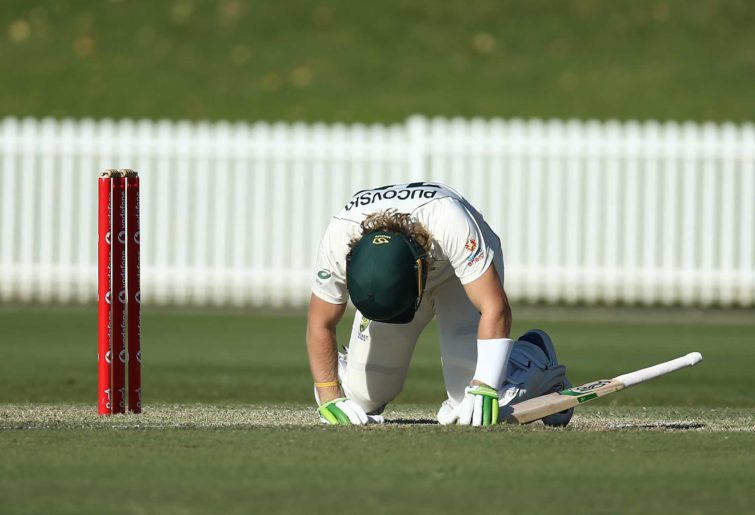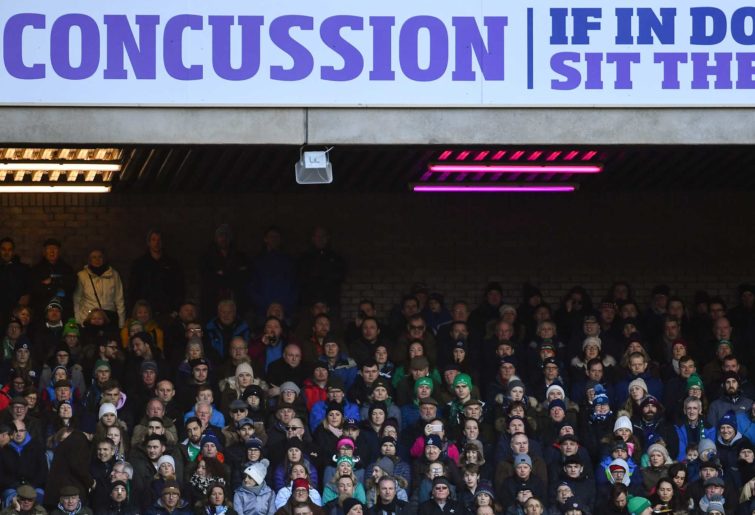During trans-Tasman rugby’s brief off-season, there’s been no hiding from the issue of concussion.
In December, it was announced that a group of eight players, including England’s 2003 World Cup winning hooker, Steve Thompson, were in the process of lodging a notice of claim against World Rugby and the English and Welsh rugby authorities, for negligence, claiming that the sport has left them with permanent brain damage.
Those seeking diversion in the Australia versus India cricket series couldn’t escape conjecture about the wisdom of exposing exciting new batting prospect Will Pucovski, sufferer of nine previous concussions, to the Indian pace attack.

Will Pucovski has been regularly concussed in his young career. (Photo by Jason McCawley/Getty Images)
The AFL pre-season too has been dominated by revelations that ex-Richmond player, Shane Tuck, suffered from severe CTE (chronic traumatic encephalopathy), a condition that almost certainly played a role in his untimely death, and the AFL amending return to play protocols, to ensure that any player concussed one week, cannot play the next.
It’s a topic that is complex and understandably emotive; people’s livelihoods and indeed their lives, are at stake. Taken to the extreme, concussion is an existential threat to the game of rugby itself, as it is to all contact sports.
It is possible however, to compartmentalise the key issues, and map a path forward for rugby, that – at least on all the known evidence – should ensure that the sport isn’t overcome by the weight of financial claims, nor denied the junior participants it needs to prosper into the future.
For simplicity’s sake, it is helpful to separate concussion into two distinct areas; the prevention/minimisation of head injuries, and the management of players who suffer from concussion.
With respect to prevention, as the body responsible for the laws of the game and their adjudication, the buck stops with World Rugby. In 2019, a comprehensive plan to reduce injuries was announced, derived from years of evidence-based consideration. Work, via a number of sub-committees, is ongoing.
Almost certainly, despite grizzling from old timers lamenting the game ‘going soft’, the push to lower tackle heights has further to run. Get used to more anatomy lessons on armpits and nipple lines, and upright tackles being phased out of the game.
Expect to see new guidelines and limitations to the amount of contact training permitted. Favoured by coaches as a means to simulate high-pressure match situations, rugby will need to become smarter and more strategic around preparation.
At the junior level, the age at which players will be prevented from playing full contact rugby will likely increase. And, noting the high incidence of concussions occurring to the tackling player, even more emphasis will be placed on teaching correct tackle technique.
Judiciary processes and outcomes are an area ripe for improvement.

Rugby league and union head injuries are a concern. (Photo by Cameron Spencer/Getty Images)
Recent rumblings out of Daceyville suggest that efforts are being made to ensure Lachie Swinton – sent off in a November Test match against the All Blacks for making deliberate high contact with his shoulder, and suspended for four matches – will be available for the start of the Super Rugby AU season.
We have seen similar instances in the past, where suspended Test players make themselves available for clubs they haven’t set foot in for years, or nominate a third grade trial match as one in which to serve out a suspension.
Should the Waratahs receive praise from their fans for doing everything they can to get an important player back on the pitch as soon as possible? Or should they be condemned for sending the message that if you hit another player in the head through over-aggression, we will try to game the system, to get you back sooner?
Given that Swinton – through the ineptitude of the match officials and the SANZAAR judiciary process – escaped sanction for a similar incident on Isi Naisarani a few weeks earlier, it would seem that the best interests of the game are not being served by the failure to send an unequivocal deterrent message.
With respect to player management, there can be no question that rugby’s culture has come a long way from the days of players wearing concussion as a badge of honour. Compliance with initial assessments and return to play protocols appears to be high.
Rugby’s protocols are also designed to allow for players recovering at different rates, from concussions that vary from mild to serious, with Melbourne Rebels CEO Baden Stephenson, confirming that in all cases, a doctor recommends, directs and overrules coaches and players in all forms of concussion injuries.
Rugby AU Player’s Association CEO, Justin Harrison, also supports the view that existing concussion management and return to play protocols are robust and comprehensive, and represent global best practice, pointing also to the ‘blue card’ process and amount of education occurring in community and junior rugby.
There remain however, concerns. Melbourne neurophysiologist Alan Pearce recently echoed a New Zealand study which found that the brain does not return to normal function until around thirty days following a concussion.
One potential implication is that, despite a player feeling ‘better’ and passing all of the protocols in order to play within a week, such protocols may in fact not be fit for purpose.
This is evidently the position adopted by the AFL, in extending the minimum time allowable for a concussed player to return to play from six days to twelve.
This change in policy serves the dual purpose of increasing the likelihood of a better health outcome (an assumption that a longer rest period must provide some additional benefit), and being a quantifiable action to demonstrate enhanced duty of care.
However, some critics, such as South Australian lawyer Greg Griffin, have labelled the move as cynical, and a belated attempt to improve the optics for the AFL, after years of inaction.
One problem, evident throughout the COVID-19 crisis, is that medical experts do not always agree, and are increasingly being used to validate positions at opposite ends of an argument.
Wales winger George North has suffered serious, high-profile concussions on an annual basis since 2015. There is a high degree of discomfort in watching these repeated instances, knowing that after each one, doctors continue to pass him fit to return to play, instead of imploring him to retire.
In November, Canterbury’s Tom Sanders was passed fit by medics and allowed to play on for almost thirty minutes after suffering a blow to the head against Wellington, despite the referee raising concern at obvious signs that Sanders wasn’t right.
Another issue is that all current protocols rely on the willingness of players to participate honestly, and not to try to hasten their return. AFL players Koby Stevens, Kade Kolodjashnij and Paddy McCartin all recently confirmed that players, eager not to give their starting spot away, fudge baseline Tests in order to be passed fit after a later head knock.
Also of high concern are not the cases where there is an obvious concussion and the player is immediately managed through the process, but instances where players receive head knocks that are not picked up by medical staff (often at training), which the player does not report.
In a chat last week with Rebels’ captain and Wallabies’ fullback Dane Haylett-Petty, he welcomed the prospect of introducing an automatic stand-down which prevented concussed players being passed fit to play the following week, while understanding the motivation of some players to advance the process.
“It’s ok for older players like me, who are more experienced and can see the bigger picture, but for some players trying to establish themselves, it might be difficult for them to voluntarily rule themselves out and give up opportunities to play,” he said.
There are two main factors driving the actions of rugby’s administrators.
The most important is that the game has an obligation to look after the welfare of its players to the very best of its ability, aligned with the scientific evidence available at the time.
Rob Nichol, CEO of the New Zealand Rugby Players Association, and previous head of the International Rugby Players Association, played an important role in working with World Rugby to oversee the introduction of pitch-side HIA’s in 2012, and further refining of concussion protocols for all levels of the game.
It is his view that rugby has continued to lead the way in the area of concussion, telling me last week that; “It’s complex, the platform constantly changes, and there’s so much that is still unknown, but I think it’s fair to say that rugby has dealt with concussion professionally and admirably, with player welfare concerns always at the forefront.”
The second reason is that if rugby is proven to be negligent or, as in the case of the NFL, was shown to be privy to knowledge about concussion and did not act, then not only would rugby be morally bereft, it will likely be set on the path to financial ruin.
In this respect, it is difficult to determine where the UK case will provide satisfaction for the litigants, who will need to establish a direct link between their injuries and suffering, to negligence on the part of administrators.

A concussion advert during the Guinness Six Nations Rugby Championship match between Scotland and Ireland at BT Murrayfield Stadium in Edinburgh, Scotland. (Photo By Ramsey Cardy/Sportsfile via Getty Images)
In the meantime, rugby will need to continually re-set, so that its actions remain in step with what continues to evolve as the best science of the day, so that players and potential new players, can be as certain as possible that what they are signing up for – to play a contact sport that holds some inherent, accepted risk – does not entail undue or unnecessary risk.
In that context, what is of most concern in the Shane Tuck case, was the revelation that Tuck did not suffer any notable on-field instances of concussion, where he was required to leave the field and undergo assessment and treatment.
A number of medical experts in the field of neuroscience have highlighted the crippling effects of cumulative, seemingly minor concussions, known as sub-concussive hits, as a leading cause of CTE. One obvious inference is that the newly announced twelve day return to play minimum would have had no effect whatsoever on Tuck’s condition.
This also has clear implications for junior participation – not just in rugby but in how parents and educators address the general issue of sport and play for children.
The nature of rugby suggests that concussion can ever be eliminated, nor the game made completely safe. Thus, rugby’s administrators must continue to strive to do all that they can to mitigate risk; to reasonably protect players from receiving concussions in the first place, and caring for them appropriately if they do, and to remain aware and agile enough to shift position should medical evidence demand.
It is not enough for rugby to look at other sports like rugby league as a benchmark and feel satisfied by comparison. There can be no room for Swinton and Sanders-like slip-ups.
Finally, fans should understand that if rugby happens to be compromised as a result of tip-toeing around this concussion minefield, that’s still a far better outcome than the game being blown off the map altogether.































































































